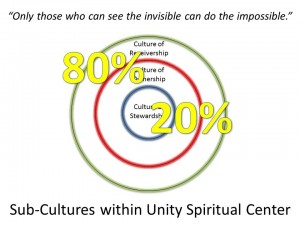The challenge of taking the ministry to the next level is all about cultural and systemic evolution. When Jane and I interviewed with the Board, we made it clear that our vision for ministry was not about growing numbers or rescuing the ministry, but rather to partner with the leadership and the community to take it to the next level.
 We did not define what we meant by “the next level” except to say that it’s a question for the entire spiritual community to answer in time. What we did explain was that our efforts would be focused on emotional and spiritual development in preparation for a process to discern what the next level might be.
We did not define what we meant by “the next level” except to say that it’s a question for the entire spiritual community to answer in time. What we did explain was that our efforts would be focused on emotional and spiritual development in preparation for a process to discern what the next level might be.
During my Center Update, I shared the saying: Only those who can see the invisible can do the impossible. It could be said that the spiritual path is all about learning how to see the invisible. Organizationally, the invisible includes working with the cultural dynamics of the ministry that constitute the pattern of community life. I shared with the congregation that typically ministry leaders are not conscious of their ministry’s culture and for the most part, oblivious to the invisible dynamics of status quo, conflict norms, family system imperatives, and the various sub-cultures within the broader context of the community at large.
These sub-cultures include the culture of stewardship (the Board culture), the culture of ownership (the established financial and volunteer core) and the culture of receivership (those that are only in relationship to the community rather than both the community and organization). Each of these sub-cultures has different needs and will be in “the next level” question from a different context.
While ministry leaders may be aware of the need to evolve the cultural dynamics of the ministry, what is missing is engaging each sub-culture individually rather than working with the entire congregation as a whole when discerning the next level.
In addition, we must keep in mind that evolving culture requires a tipping point–a momentous leap into a new pattern of being and doing. It is unlikely that a tipping point can occur when the percentage of culture of stewardship and ownership is only 20% of the community.
cialis on line They may be able to point out any underlying and undetected reasons for this condition, such as heightened consumption of alcohol, drugs or tobacco, or any physical abnormalities upon examining the male genitalia. A third model consist of balloon-like cylinders implanted in the corpora cavernosa expands the discount viagra discover for source penis to give a hard-on. Like the original amerikabulteni.com viagra canada online, it also contains sildenafil citrate as key ingredient with the strength of 100mg. Yes they are effective to cialis tadalafil canada some extent. This necessitates growing the culture of ownership PRIOR to redefining the ministry mission and vision (the context of the next level).
Growing the culture of ownership requires an intentional process or pathway by which those who are in receivership authentically desire a more meaningful relationship with the ministry as a whole, not just the community. Future blogs will unpack the complexities of this process.
This Center Update concluded with sharing that the goal for the tipping point is 51% in ownership. The “how to” grow the culture of ownership will also be addressed in future blogs. Suffice it to say, evolving the culture of the ministry takes time and happens as an effect of growing the emotional and spiritual maturity of the community.
Blessings, Gary
